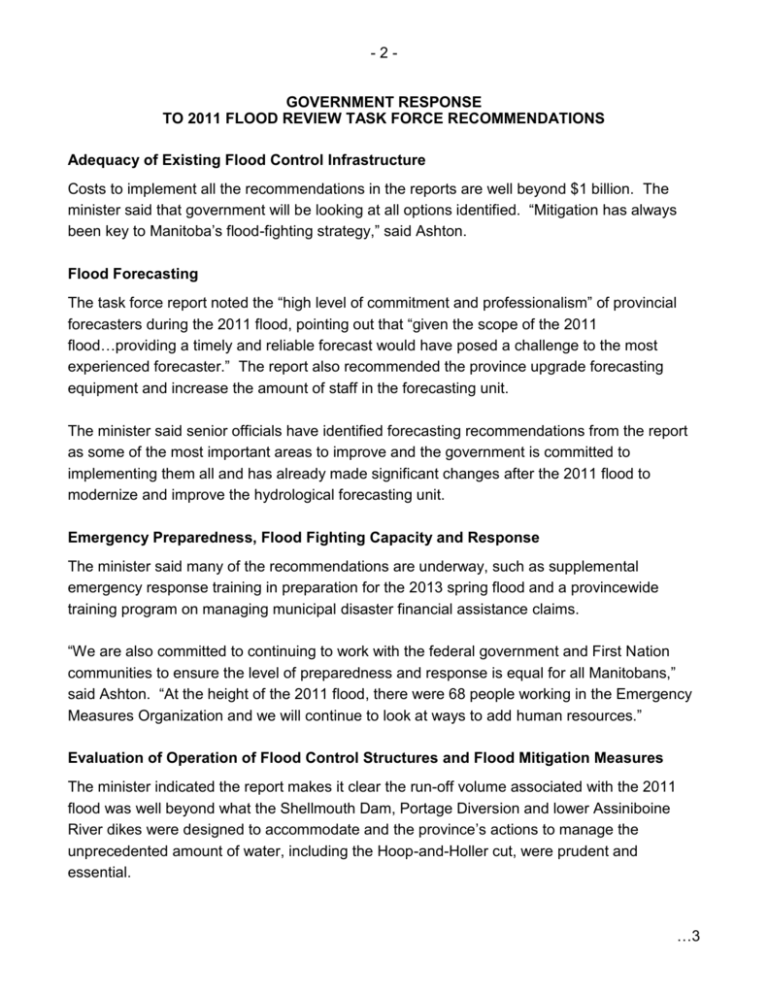2 - GOVERNMENT RESPONSE TO 2011 FLOOD REVIEW TASK
advertisement

-2GOVERNMENT RESPONSE TO 2011 FLOOD REVIEW TASK FORCE RECOMMENDATIONS Adequacy of Existing Flood Control Infrastructure Costs to implement all the recommendations in the reports are well beyond $1 billion. The minister said that government will be looking at all options identified. “Mitigation has always been key to Manitoba’s flood-fighting strategy,” said Ashton. Flood Forecasting The task force report noted the “high level of commitment and professionalism” of provincial forecasters during the 2011 flood, pointing out that “given the scope of the 2011 flood…providing a timely and reliable forecast would have posed a challenge to the most experienced forecaster.” The report also recommended the province upgrade forecasting equipment and increase the amount of staff in the forecasting unit. The minister said senior officials have identified forecasting recommendations from the report as some of the most important areas to improve and the government is committed to implementing them all and has already made significant changes after the 2011 flood to modernize and improve the hydrological forecasting unit. Emergency Preparedness, Flood Fighting Capacity and Response The minister said many of the recommendations are underway, such as supplemental emergency response training in preparation for the 2013 spring flood and a provincewide training program on managing municipal disaster financial assistance claims. “We are also committed to continuing to work with the federal government and First Nation communities to ensure the level of preparedness and response is equal for all Manitobans,” said Ashton. “At the height of the 2011 flood, there were 68 people working in the Emergency Measures Organization and we will continue to look at ways to add human resources.” Evaluation of Operation of Flood Control Structures and Flood Mitigation Measures The minister indicated the report makes it clear the run-off volume associated with the 2011 flood was well beyond what the Shellmouth Dam, Portage Diversion and lower Assiniboine River dikes were designed to accommodate and the province’s actions to manage the unprecedented amount of water, including the Hoop-and-Holler cut, were prudent and essential. …3 -3- The report identified the structural vulnerability of the lower Assiniboine Dikes. The minister said the province began implementing many recommendations for improving flood control structures including hiring staff to increase provincial dam inspections, initiating a detailed study of the Assiniboine River diking system as part of the Assiniboine River-Lake Manitoba Flood Mitigation Study, and taking preliminary steps to enhance the Shellmouth gate project to reduce the impact of flooding in small to medium-sized flood. Environmental impacts The report said impacts on habitat and fish will be unknown for many years. The minister said the province is committed to analyzing ongoing environmental impacts that may be caused by flooding, adding Manitoba Conservation and Water Stewardship has already undertaken extensive water sampling tests on Lake Manitoba to better understand the impacts of flooding on the lake. The department also took aerial surveys of the lake for debris and will work with municipalities on developing a strategy to remove any remaining hazardous material from the lake, he said. First Nations The report emphasizes and identifies the long-standing issue of inadequate land-use planning and internal drainage issues, which continue to disrupt First Nation communities during floods. The government knows that proactive measures taken to protect communities from floods are the most effective way to limit damages, said Ashton. In many cases, the province has gone beyond its jurisdiction to assist First Nation communities to protect themselves. For example, it helped to fund LiDAR surveys of the Fisher River that helped to solidify a deal with Peguis First Nation and the federal government to move 75 homes from harm’s way. The province also purchased portable flood barriers and steamers to be used on First Nations. Ashton said the government takes this section of the report very seriously and is committed to ensuring First Nations are protected to the same level as every other Manitoban. The minister said the reports will guide the province as it moves forward in its efforts to improve flood protection, forecasting and emergency response. “Coming out of 2011 we can say with certainty that we are stronger than ever before,” said Ashton. “We accept the recommendations in both the reports and have already moved forward on more than 75 per cent of the recommendations.” Lake St. Martin and Lake Manitoba Regulation Review The minister said the government accepts this report’s recommendations.






